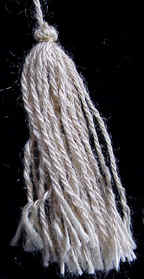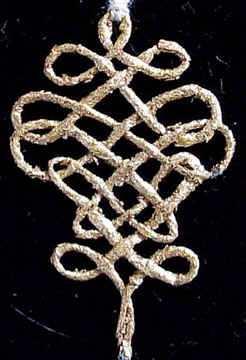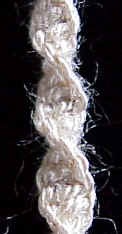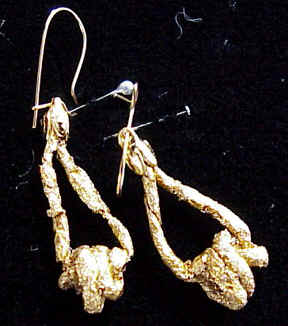Looking through a
museum magazine, I came across a beautiful silver pin made from knotted silver wire. I
sketched a copy of the pin for further reference (sample G1). For along time I had been
milling over the idea of spinning metal. This gave me the incentive to investigate
thoroughly and an idea for a project.
So far steal wool was the only source of spinnable metal, but not
very nice on the hands. Over the next few days I pondered over the idea of other
possibilities of spinning metal suitable for knotting. My mind flashed back to my
childhood of arts and crafts. Gold leaf was popular, inexpensive and used for craft items.
If it had any of the properties of paper that it looked like it might spin into a suitable
thread. I knew gold thread and wire was used for knotting.
The search for gold leaf was on. Now twenty years later was it
available? Would it be prohibitively expensive? First I searched my Mothers old craft
cupboards. Eureka! A whole package of gold leaf was till around. It was some of the
original 24K gold leaf (sample G2). Now available in the stores is metal alloys at a very
high cost.
First attempt (sample G3): I tried tearing the leaf into strips
as I would paper to spin. So far so good, but some stuck to my fingers. Powder fingers
first. Next I tried twisting as I would a wool sample. It broke apart like brittle chafe.
After thirty minutes and one sheet of leaf later I had two inches of gold too brittle and
weak to use.
Second attempt (sample G4): Tried to spin over existing thread as
a core yarn. I tore the leaf into one inch strips and laid a sewing thread over the gold.
Picking up the thread and the leaf I began to twist, somewhat successful. No more time for
a week to touch it, plenty of time to think.
Third attempt (sample G5): Sprayed adhesive on linen thread.
Positioned 1 1/2 inch strips of gold leaf on paper. Core spun gold leaf around linen. Too
little gold leaf stuck to the linen.
Fourth attempt (sample G6): Sprayed adhesive on gold leaf. Core
spun gold leaf around linen. These past two attempts seemed a bit like gluing gold leaf
on, the leaf did not really want to spin!
Fifth attempt (sample G7): Positioned 1 1/2 inch strips of gold
leaf on paper, a few very delicate strands of unspun line linen was placed on the
gold leaf. Sprayed very lightly with adhesive. Spun gold leaf and linen together. Gold
leaf was then in and around the linen thread and it was actually twisting and holding
together. Cutting into the thread revealed that the gold was indeed all the way through
the thread. This thread was then sealed with clear enamel to cut down on the gold flaking
off during knotting.
I repeated the fifth technique a second time, also with good
results. This yarn I knotted into the pin pattern from the Smithsonian. The yarn held up
well to the knotting (sample G8). I do not feel that it would hold up to wear and tear.
The final knot was dipped in clear plastic to preserve it.
To display the pendant, I spun tussah silk in to a fine single
(sample G9) with extra Z twist. It was then Navajo plied (sample G10). This thread was
used to knot a necklace. The familiar knot used for the necklace comes with many names:
macramé knot, half square knot, half hitch sennit. The necklace slips over the head and
is finished with a traditional tassel. Two tassels are tied to the bottom of the pendant
with a button knot. The simple earrings are made with a triple connection knot. |
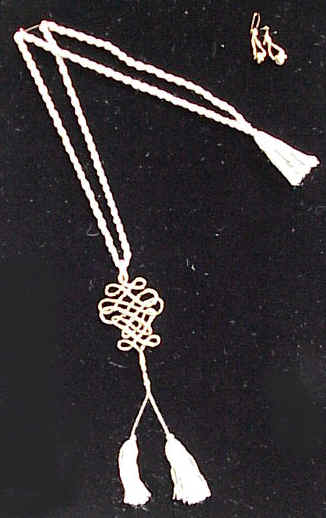
![]() This is
an overview of the project. More detailed pictures follow. All parts of the
project were handspun. The Tussah silk made an especially beautiful cord.
This is
an overview of the project. More detailed pictures follow. All parts of the
project were handspun. The Tussah silk made an especially beautiful cord.